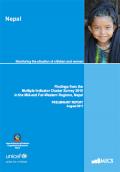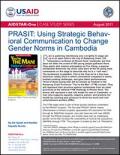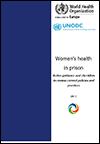What's New
Displaying results 3191 - 3200 of 4052

Resource | Reviews and Snapshots,
The reported cumulative number of Koreans testing positive for HIV has more than doubled in the last five years from 2,470 in 2003 to 6,936 in March 2010. The number of newly recorded HIV cases in the Republic of Korea decreased by about 3% (771 new cases) in 2009 after a 7% increase in 2008 (797 new cases), according to a report released from the Korea Centers for Disease Control and Prevention (KCDC).

Resource | Publications,
The Nepal Demographic and Health Survey (NDHS) 2011 is conducted as a periodic update of the demographic and health situation in Nepal. This is the fourth comprehensive national level population and health survey conducted in Nepal as part of the global Demographic and Health Surveys (DHS) program.
The primary focus of the 2011 NDHS was to provide estimates of key population and health indicators, including fertility and mortality rates, for the country as a whole and for urban and rural areas separately. In addition, the sample was designed to provide estimates of most key variables for the 13 ecodevelopment regions (stratums).

Resource | Publications,
In low- and middle-income countries, substantial resources for the AIDS response come from the largest bilateral, multilateral, and private philanthropic donors and from a country’s contribution to addressing its own epidemic. There is no reliable indication of what overall proportion of these resources ultimately reaches men who have sex with men (MSM) and transgender people.
Our objective was to examine major donor investments targeted at these two groups in 2009, but we also recorded relevant information from other years (2008, 2010, and 2011) when available.

Resource | Publications,
This preliminary report is based on the Nepal Multiple monitor progress made over the past decade on children's Indicator Cluster Survey (NMICS), conducted in 2010 by and women's issues. It will also help to identify the regional the Central Bureau of Statistics (CBS) with technical and geographical disparities that exist within the country financial support from UNICEF. The survey is intended, in and will establish a baseline for some newly developed large part, to fill the data gap that has existed in the Mid-Western and Far-Western regions of Nepal in addition to indicators, the progress status of which can be monitored preparing for the national-level MICS in 2013.

Resource | Publications,
There is now overwhelming evidence that the epidemic among MSM (Men who have Sex with Men) is well established and increasing. While some actions are now being put in place on a regional and country basis to address prevention amongst MSM, there has been very little work done in regards to the issues for MSM who are already positive. To fulfil this gap, community-based organisations of positive people linked to the Asia Pacific Network of People Living with HIV (APN+) through a participatory research methodology, learned to design and implement a study to explore the issues affecting positive MSM in the region.
This study provides a timely critique on the lack of community-centred discussions surrounding sex, sexuality, and sexual identity. The ongoing global attention on quantifiable markers to health, universal access to treatment, medication adherence and condom use, while certainly important, only skim the surface of deeper quality of life for positive MSM; which necessarily depends on looking deeper into the meanings HIV has had on the lives and stories of those who have to live with it. Thus, it has been found that positive MSM in the Asia Pacific are left to mend their lives, their sexual identities, and relate anew post-HIV with the world outside, the best they can; in many cases with minimal social or institutional support. This gross injustice needs to be redressed if we are truly serious about being sensitive and responsive to the actual needs of communities affected by HIV. Perhaps only then will we have an enabling environment and politics that are yet to be.

Resource | Publications,
The report is intended to provide an evidence-base for: policy makers working in government, regional and multilateral organizations; parliamentarians; members of the judiciary; civil society organizations; donor agencies; and sex workers and their organisations engaged in advocacy to improve the legal and policy enabling environment for HIV responses. The first Asia and the Pacific Regional Consultation on HIV and Sex Work (2010) highlighted the need to document laws and enforcement practices so as to inform advocacy and programming to address the human rights of sex workers. The study focuses on 48 countries of the Asia Pacific region. The study method involves: review of legislation, cases, published research and grey literature; consultations with sex workers, technical experts and UN agencies; and analysis. This consultation draft relates to the Pacific region, Australian and New Zealand. Separate consultation reports have been prepared for the Asian regions.
The study focuses on laws and law enforcement practices affecting adults engaged in sex work. The study does not aim to map laws relating to children who are sexually exploited. Although the study considers the relevance of trafficking laws particularly as it affects adults voluntarily engaged in sex work, it does not map all trafficking legislation in detail.

Resource | Publications,
After peaking at 3.2 percent in 1997, Cambodia's HIV prevalence among men and women aged 15 to 49 had dropped to 0.9 percent; it is expected to decline to approximately 0.6 percent by 2012 (Ministry of Health [MOH] 2007). HIV in Cambodia has evolved from a generalized epidemic to one concentrated among MARPs: men who are clients of sex workers as well as their spouses; people who inject drugs; male, female, and transgender sex workers, and MSM.

Resource | Guidelines,
The checklists in this document are an important tool in ensuring greater safety and better quality medical care for women in prison, and are designed to assist a review of current policies and practices relating to women’s health in prisons.

Resource | Publications,
The present document aims to review the progress of the HIV response in the Asia-Pacific region, with a view to identifying the opportunities for further action afforded by the 2011 Political Declaration. In doing so, it also draws on the expressed commitments undertaken by ESCAP member States to address the HIV epidemic, including those reflected in resolutions 66/10, Regional call for action to achieve universal access to HIV prevention, treatment, care and support in Asia and the Pacific (19 May 2010) and 67/9, Asia-Pacific regional review of the progress achieved in realizing the Declaration of Commitment on HIV/AIDS and the Political Declaration on HIV/AIDS (25 May 2011).

Resource | Publications,
A total of 35 positive HIV cases were confirmed in the Federated States of Micronesia (FSM) as of December 2007 (UNAIDS 2008). The majority (62.8%) of these cases were aged between 25-44 years and 68.5% were male. The main mode of transmission is via heterosexual intercourse. Chuuk accounts for the majority of HIV positive cases in FSM, with a total of 22 cases having been detected up to the time of writing this report. Three of the 22 people who have tested positive a still alive.





